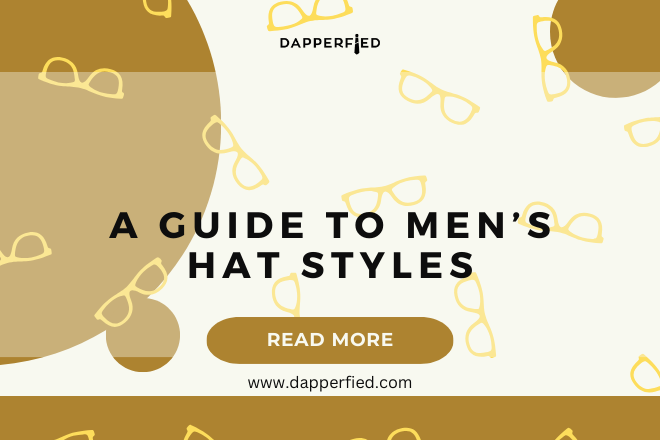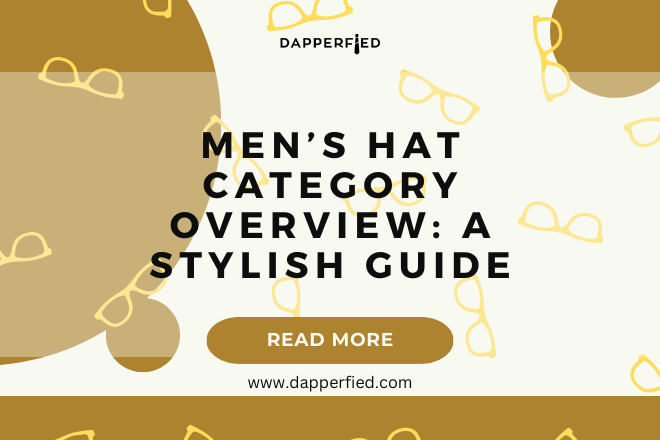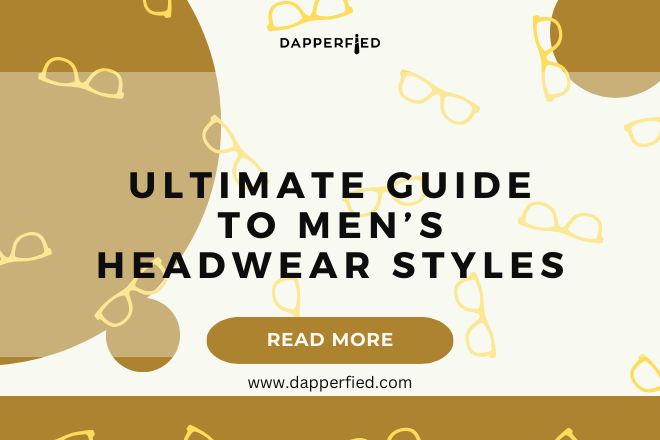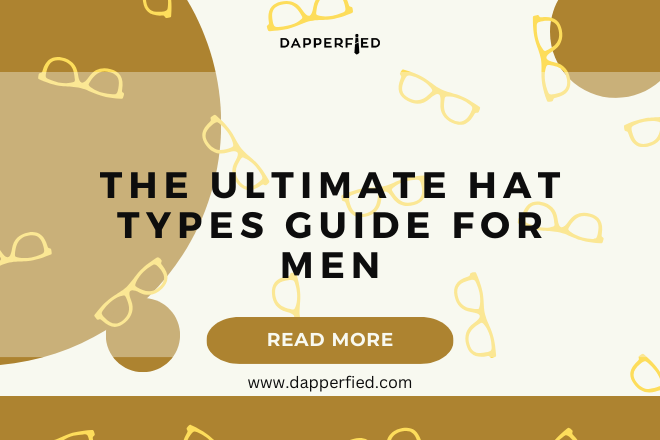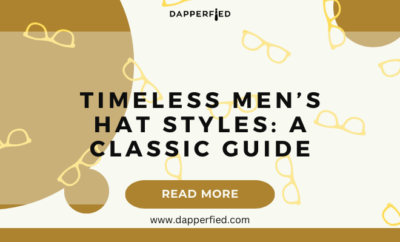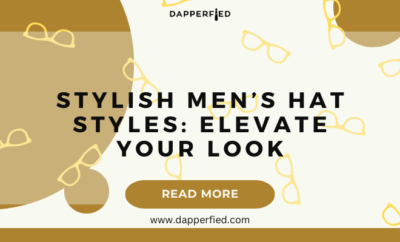
Men's Style
Men’s Hat Selection Guide: Find the Perfect Style
Hats come in a wide variety of styles, each with its own unique characteristics and history. One of the most popular hat styles is the fedora, which is characterized by its wide brim and creased crown. This classic hat has been a staple in men’s fashion for decades and is often associated with sophistication and style.
Another popular style is the baseball cap, which is known for its casual and sporty look. This type of hat typically has a rounded crown and a stiff brim, and is often worn for outdoor activities or as a fashion statement. The bucket hat is another trendy style that has made a comeback in recent years.
This hat features a wide, downward-sloping brim and a soft, unstructured crown, making it a popular choice for casual, laid-back looks. On the more formal end of the spectrum, we have the top hat, which is characterized by its tall, flat crown and narrow brim. This iconic hat has been a symbol of elegance and sophistication for centuries and is often worn for special occasions such as weddings and formal events.
The beret is another classic style that has been popularized by artists and intellectuals. This soft, round hat is typically made of wool or felt and is often associated with creativity and bohemian style. Finally, the Panama hat is a timeless summer staple that features a wide brim and a lightweight, breathable construction.
This hat is perfect for keeping cool in hot weather and is often worn for outdoor activities such as picnics and beach outings.
Key Takeaways
- There are various hat styles such as fedora, bucket, beanie, baseball cap, and beret, each with its own unique characteristics and history.
- When choosing a hat, consider your face shape and opt for a style that complements your features, such as a wide-brimmed hat for a round face or a fedora for a square face.
- Different materials like wool, straw, felt, and cotton offer different levels of breathability, warmth, and durability, so choose one that suits your climate and lifestyle.
- To find the right size and fit, measure your head circumference and consider the hat’s crown height, brim width, and overall shape to ensure comfort and style.
- Coordinate your hat with your outfit by considering color, pattern, and formality, and choose a hat that enhances your overall look for any occasion.
- When selecting a hat, think about its functionality and practicality for the event or activity you’ll be wearing it for, and invest in quality materials for longevity.
- Properly care for your hat by storing it in a cool, dry place, cleaning it according to its material, and reshaping it as needed to maintain its shape and appearance.
Choosing the Right Hat for Your Face Shape
Round Face Shape
When it comes to round face shapes, hats with angular or structured designs can help add definition and balance to the face. Styles such as fedoras or baseball caps with a slightly curved brim can help elongate the face and create a more flattering silhouette.
Square, Oval, and Heart-Shaped Face Shapes
On the other hand, those with a square face shape can opt for softer, more rounded hat styles such as bucket hats or berets to soften the angles of the face. If you have an oval face shape, you’re in luck! This versatile face shape can pull off almost any hat style with ease. For those with a heart-shaped face, hats with medium brims and moderate height crowns can help balance out the wider forehead and narrower chin.
Long or Oblong Face Shape
Lastly, for those with a long or oblong face shape, hats with wider brims and shorter crowns can help create the illusion of width and balance out the length of the face. Styles such as bucket hats or wide-brimmed sun hats can help add volume to the sides of the face and create a more proportional look.
Selecting the Perfect Material for Your Hat

The material of a hat plays a crucial role in its overall look, feel, and functionality. When choosing a hat, it’s important to consider the climate and occasion for which you’ll be wearing it. For warm weather, lightweight and breathable materials such as straw, cotton, or linen are ideal choices.
Straw hats, such as Panama hats or boater hats, are perfect for summer outings and outdoor events, as they provide excellent ventilation and sun protection. Similarly, cotton or linen hats are great options for casual wear and can be easily styled with a variety of outfits. In colder weather, wool and felt hats are popular choices for their warmth and durability.
Styles such as fedoras or berets made from these materials are perfect for adding a touch of sophistication to winter ensembles while keeping you cozy and comfortable. Additionally, leather hats are a stylish option for both warm and cold weather, as they provide a sleek and polished look while offering protection from the elements. Whether it’s a classic leather baseball cap or a stylish leather fedora, these hats are versatile enough to be worn year-round.
For those looking for a more sustainable option, there are also eco-friendly hat materials to consider. Hats made from recycled materials such as polyester or organic cotton are not only environmentally conscious but also offer the same level of comfort and style as traditional materials. By choosing hats made from sustainable materials, you can make a positive impact on the environment while still looking fashionable.
Finding the Right Size and Fit
| Size | Fit | Measurement |
|---|---|---|
| Small | Slim Fit | 32-34 inches |
| Medium | Regular Fit | 36-38 inches |
| Large | Loose Fit | 40-42 inches |
Finding the right size and fit for your hat is essential for both comfort and style. A hat that is too tight can cause discomfort and headaches, while one that is too loose may slip or fall off easily. To determine your hat size, use a flexible measuring tape to measure the circumference of your head at the widest part, typically just above your eyebrows and ears.

Once you have your measurement in inches or centimeters, refer to a size chart to find your corresponding hat size. When trying on hats, pay attention to how they feel on your head. The hat should fit snugly without feeling too tight or leaving marks on your forehead.
If you’re between sizes, opt for the larger size and use sizing tape or foam inserts to adjust the fit as needed. Additionally, consider the height of the crown and the width of the brim when choosing a hat style that complements your head shape. A well-fitted hat should sit comfortably on your head without feeling too heavy or unbalanced.
It’s also important to consider any hair accessories or hairstyles that you may want to wear with your hat. If you have long hair or frequently wear ponytails or buns, choose a hat with enough depth in the crown to accommodate your hairstyle without feeling too tight or restrictive. Similarly, if you have short hair or prefer sleek styles, opt for hats with a more tailored fit that won’t overwhelm your head shape.
Matching Your Hat with Your Outfit
Matching your hat with your outfit is an art form that can elevate your overall look and make a stylish statement. When choosing a hat to complement your outfit, consider the color palette, texture, and overall aesthetic of your clothing. For a cohesive look, opt for hats that either match or complement the colors in your outfit.
Neutral-colored hats such as black, brown, or navy are versatile options that can be easily paired with a variety of ensembles. If you’re feeling bold, consider adding a pop of color with a statement hat that contrasts with your outfit in a complementary way. For example, pairing a red fedora with an all-black ensemble can add an unexpected touch of personality and flair to your look.
Additionally, consider the texture of your hat in relation to your clothing. For casual outfits with relaxed fabrics such as denim or cotton, opt for hats with similar textures such as straw or canvas for a cohesive look. When it comes to formal attire, choose hats that exude elegance and sophistication to complement your ensemble.
Classic styles such as fedoras or top hats in neutral tones are timeless choices that can add an air of refinement to formal suits or evening gowns. Pay attention to details such as embellishments or trims on your hat to ensure they complement any accessories or jewelry you may be wearing.
Considering the Occasion and Functionality

Everyday Wear
For casual, everyday wear, opt for versatile hat styles that offer both comfort and practicality. Baseball caps and bucket hats are perfect for running errands, outdoor activities, or adding an effortless touch to your daily outfits.
Special Occasions
For special occasions such as weddings or formal events, consider more refined hat styles that exude elegance and sophistication. Fascinators and wide-brimmed hats are statement-making accessories that can elevate your ensemble, make you stand out in a crowd, and add an element of glamour to your look.

Functionality and Climate
When it comes to functionality, consider the purpose of your hat beyond just aesthetics. If you’ll be spending time outdoors in sunny weather, prioritize hats with UV protection, such as wide-brimmed sun hats or straw fedoras, that offer shade and sun protection. In colder climates, opt for wool or felt hats that provide warmth and insulation while still looking stylish.
Maintaining and Caring for Your Hat
Proper maintenance and care are essential for preserving the quality and longevity of your hat. Depending on the material of your hat, there are specific care instructions to follow to ensure it stays in top condition. For straw hats, gently brush off any dirt or debris using a soft-bristled brush and store them in a cool, dry place away from direct sunlight to prevent fading or discoloration.
For wool or felt hats, use a lint roller or soft brush to remove any dust or lint from the surface of the hat. If your hat becomes misshapen, steam it gently over boiling water to reshape it back to its original form. Avoid exposing wool or felt hats to excessive moisture or heat, as this can cause them to lose their shape or shrink.
Leather hats should be treated with a leather conditioner to keep them supple and prevent cracking over time. Store leather hats in a cool, dry place away from direct sunlight to prevent fading or discoloration. Regardless of the material, always handle your hats with clean hands to avoid transferring oils or dirt onto them.
When not in use, store your hats on a hat rack or in a breathable storage box to maintain their shape and prevent them from getting crushed. In conclusion, choosing the right hat involves considering various factors such as style, face shape, material, size, outfit coordination, occasion, functionality, and maintenance. By taking these elements into account when selecting a hat, you can ensure that it not only looks great but also serves its purpose effectively while standing the test of time with proper care and maintenance.
Whether you’re looking for a casual everyday hat or an elegant statement piece for special occasions, there’s a perfect hat out there for everyone when armed with this knowledge.
If you’re interested in learning more about men’s fashion from different eras, you should check out this article on 1920s men’s suits for a brief history. It provides a fascinating look at the evolution of men’s fashion and how it has changed over time. (source)
FAQs
What are the different types of hats for men?
There are various types of hats for men, including baseball caps, fedoras, trilbies, bucket hats, beanies, flat caps, and cowboy hats, among others.
How do I choose the right hat for my face shape?
When choosing a hat for your face shape, consider the following guidelines:
– Oval face: Most hat styles will suit this face shape.
– Round face: Opt for hats with angular lines to add definition.
– Square face: Look for hats with rounded crowns and soft lines to balance the sharp angles.
– Heart-shaped face: Choose hats with medium brims and moderate height to complement the wider forehead and narrower chin.
– Long face: Go for hats with a wide brim to add width and balance out the length of the face.
What materials are hats made from?
Hats for men are made from a variety of materials, including wool, felt, straw, cotton, leather, and synthetic fabrics. Each material offers different levels of durability, breathability, and style.
How do I determine the right hat size?
To determine the right hat size, measure the circumference of your head just above your ears and eyebrows. Use this measurement to find the corresponding hat size in the brand’s sizing chart. It’s important to ensure a snug but not tight fit for comfort.
How do I care for my hats?
The care for hats depends on the material. Generally, hats should be stored in a cool, dry place and protected from dust and moisture. Felt hats can be brushed with a soft bristle brush to remove dust, while straw hats can be gently wiped with a damp cloth. Always follow the care instructions provided by the manufacturer.

